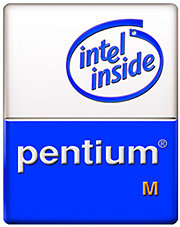|
Pentium M
The Pentium M is a family of mobile 32-bit single-core x86 microprocessors (with the modified Intel P6 microarchitecture) introduced in March 2003 and forming a part of the Intel Carmel notebook platform under the then new Centrino brand. The ''Pentium M'' processors had a maximum thermal design power (TDP) of 5–27 W depending on the model, and were intended for use in laptops (thus the "M" suffix standing for ''mobile''). They evolved from the core of the last Pentium III–branded CPU by adding the front-side bus (FSB) interface of Pentium 4, an improved instruction decoding and issuing front end, improved branch prediction, SSE2 support, and a much larger cache. The first Pentium M–branded CPU, code-named Banias, was followed by Dothan. The Pentium M line was removed from the official price lists in July 2009, when the Pentium M-branded processors were succeeded by the Core-branded dual-core mobile Yonah CPU with a modified microarchitecture. It replaced the Mobile Penti ... [...More Info...] [...Related Items...] OR: [Wikipedia] [Google] [Baidu] |
P6 (microarchitecture)
The P6 microarchitecture is the sixth-generation Intel x86 microarchitecture, implemented by the Pentium Pro microprocessor that was introduced in November 1995. It is frequently referred to as i686. It was succeeded by the NetBurst microarchitecture in 2000, but eventually revived in the Pentium M line of microprocessors. The successor to the Pentium M variant of the P6 microarchitecture is the Core microarchitecture which in turn is also derived from P6. P6 was used within Intel's mainstream offerings from the Pentium Pro to Pentium III, and was widely known for low power consumption, excellent integer performance, and relatively high instructions per cycle (IPC). The P6 line of processing cores was succeeded by the NetBurst (P68) architecture which appeared with the introduction of Pentium 4. The P6 core was the sixth generation Intel microprocessor in the x86 line. The first implementation of the P6 core was the Pentium Pro CPU in 1995, the immediate successor to the or ... [...More Info...] [...Related Items...] OR: [Wikipedia] [Google] [Baidu] |
Dual-core
A multi-core processor is a microprocessor on a single integrated circuit with two or more separate processing units, called cores, each of which reads and executes program instructions. The instructions are ordinary CPU instructions (such as add, move data, and branch) but the single processor can run instructions on separate cores at the same time, increasing overall speed for programs that support multithreading or other parallel computing techniques. Manufacturers typically integrate the cores onto a single integrated circuit die (known as a chip multiprocessor or CMP) or onto multiple dies in a single chip package. The microprocessors currently used in almost all personal computers are multi-core. A multi-core processor implements multiprocessing in a single physical package. Designers may couple cores in a multi-core device tightly or loosely. For example, cores may or may not share caches, and they may implement message passing or shared-memory inter-core communicat ... [...More Info...] [...Related Items...] OR: [Wikipedia] [Google] [Baidu] |
Pentium M
The Pentium M is a family of mobile 32-bit single-core x86 microprocessors (with the modified Intel P6 microarchitecture) introduced in March 2003 and forming a part of the Intel Carmel notebook platform under the then new Centrino brand. The ''Pentium M'' processors had a maximum thermal design power (TDP) of 5–27 W depending on the model, and were intended for use in laptops (thus the "M" suffix standing for ''mobile''). They evolved from the core of the last Pentium III–branded CPU by adding the front-side bus (FSB) interface of Pentium 4, an improved instruction decoding and issuing front end, improved branch prediction, SSE2 support, and a much larger cache. The first Pentium M–branded CPU, code-named Banias, was followed by Dothan. The Pentium M line was removed from the official price lists in July 2009, when the Pentium M-branded processors were succeeded by the Core-branded dual-core mobile Yonah CPU with a modified microarchitecture. It replaced the Mobile Penti ... [...More Info...] [...Related Items...] OR: [Wikipedia] [Google] [Baidu] |
Dynamic Voltage Scaling
Dynamic voltage scaling is a power management technique in computer architecture, where the voltage used in a component is increased or decreased, depending upon circumstances. Dynamic voltage scaling to increase voltage is known as overvolting; dynamic voltage scaling to decrease voltage is known as undervolting. Undervolting is done in order to conserve power, particularly in laptops and other mobile devices, where energy comes from a battery and thus is limited, or in rare cases, to increase reliability. Overvolting is done in order to support higher frequencies for performance. The term "overvolting" is also used to refer to increasing static operating voltage of computer components to allow operation at higher speed (overclocking). Background MOSFET-based digital circuits operate using voltages at circuit nodes to represent logical state. The voltage at these nodes switches between a high voltage and a low voltage during normal operation—when the inputs to a logic gat ... [...More Info...] [...Related Items...] OR: [Wikipedia] [Google] [Baidu] |
Embedded System
An embedded system is a computer system—a combination of a computer processor, computer memory, and input/output peripheral devices—that has a dedicated function within a larger mechanical or electronic system. It is ''embedded'' as part of a complete device often including electrical or electronic hardware and mechanical parts. Because an embedded system typically controls physical operations of the machine that it is embedded within, it often has real-time computing constraints. Embedded systems control many devices in common use today. , it was estimated that ninety-eight percent of all microprocessors manufactured were used in embedded systems. Modern embedded systems are often based on microcontrollers (i.e. microprocessors with integrated memory and peripheral interfaces), but ordinary microprocessors (using external chips for memory and peripheral interface circuits) are also common, especially in more complex systems. In either case, the processor(s) used ... [...More Info...] [...Related Items...] OR: [Wikipedia] [Google] [Baidu] |
Shuttle Inc
The original meaning of the word shuttle is the device used in weaving to carry the weft. By reference to the continual to-and-fro motion associated with that, the term was then applied in transportation and then in other spheres. Thus the word may now also refer to: Transport Air transport * Air shuttle, a type of flight which quickly connects nearby destinations * Delta Shuttle, the brand name for Delta Air Lines' air shuttle service * Rossi Shuttle Quik, an Italian ultralight trike design * Shuttle America, a regional airline based in Indianapolis, Indiana * Shuttle by United, a regional airline operated as a subsidiary of United Airlines * Shuttle Carrier Aircraft, modified Boeing 747 airliners used to transport Space Shuttle orbiters * US Airways Shuttle, the brand name for an hourly service offered by US Airways * The call sign for domestic (UK internal) British Airways flights - international flights use Speedbird Land transport Automotive brands * Fit Shuttle, the sta ... [...More Info...] [...Related Items...] OR: [Wikipedia] [Google] [Baidu] |
Socket 478
Socket 478, also known as mPGA478 or mPGA478B, is a 478-contact CPU socket used for Intel's Pentium 4 and Celeron series CPUs. Socket 478 was launched in August 2001 in advance of the Northwood core to compete with AMD's 462-pin Socket A and their Athlon XP processors. Socket 478 was intended to be the replacement for Socket 423, a Willamette-based processor socket which was on the market for only a short time. Socket 478 was phased out with the launch of LGA 775 in 2004. Technical specifications Socket 478 was used for all Northwood Pentium 4 and Celeron processors. It supported the first Prescott Pentium 4 processors and all Willamette Celerons, along with several of the Willamette-series Pentium 4s. Socket 478 also supported the newer Prescott-based Celeron D processors, and early Pentium 4 Extreme Edition processors with 2 MB of L3 CPU cache. Celeron D processors were also available for Socket 478 and were the last CPUs made for the socket. While the Intel mobil ... [...More Info...] [...Related Items...] OR: [Wikipedia] [Google] [Baidu] |
HTPC
A home theater PC (HTPC) or media center computer is a technological convergence, convergent device that combines some or all the capabilities of a personal computer with a software application that focuses on video, photo, audio playback, and sometimes digital video recorder, video recording functionality. Since the mid-2000s, other types of consumer electronics, including Video game console, game consoles and dedicated media devices, have crossed over to manage video and music content. The term "media center" also refers to specialized application software designed to run on standard personal computers. HTPC and other convergent devices integrate components of a Home cinema, home theater into a unit co-located with a home entertainment system. An HTPC system typically has a remote control and the software interface normally has a 10-foot user interface, 10-foot (3 m) user interface design so that it can be comfortably viewed at typical television viewing distances. An HT ... [...More Info...] [...Related Items...] OR: [Wikipedia] [Google] [Baidu] |
Micro-Star International
Micro-Star International Co., Ltd (MSI; ) is a Taiwanese multinational information technology corporation headquartered in New Taipei City, Taiwan. It designs, develops and provides computer hardware, related products and services, including laptops, desktops, motherboards, graphics cards, All-in-One PCs, servers, industrial computers, PC peripherals, car infotainment products, etc. The company has a primary listing on the Taiwan Stock Exchange and was established on August 4, 1986 by 5 founders – Hsu Xiang (a.k.a. Joseph Hsu), Huang Jinqing (a.k.a. Jeans Huang), Lin Wentong (a.k.a. Frank Lin), Yu Xian'nengyu (a.k.a. Kenny Yu), and Lu Qilong (a.k.a. Henry Lu). First starting its business in New Taipei City, Taiwan, MSI later expanded into China, setting up its Bao'an Plant in Shenzhen in 2000 and establishing research and development facilities in Kunshan in 2001. It also provides global warranty service in North America, Central/South America, Asia, Australia and Europe. ... [...More Info...] [...Related Items...] OR: [Wikipedia] [Google] [Baidu] |
AOpen
AOPEN (, stylized AOPEN) is a major electronics manufacturer from Taiwan that makes computers and parts for computers. AOPEN used to be the Open System Business Unit of Acer Computer Inc. which designed, manufactured and sold computer components. It was incorporated in December 1996 as a subsidiary of Acer Group with an initial public offering (IPO) at the Taiwan stock exchange in August 2002. It is also the first subsidiary that established the entrepreneurship paradigm in the pan-Acer Group. At that time, AOPENs major shareholder was the Wistron Group. In 2018 AOPEN became a partner of the pan-Acer Group again as the business-to-business branch of the computing industry. They are perhaps most well known for their "Mobile on Desktop" (MoDT), which implements Intel's Pentium M platform on desktop motherboards. Because the Pentium 4 and other NetBurst CPUs proved less energy efficient than the Pentium M, in late 2004 and early 2005, many manufacturers introduced desktop mothe ... [...More Info...] [...Related Items...] OR: [Wikipedia] [Google] [Baidu] |
SpeedStep
Enhanced SpeedStep is a series of dynamic frequency scaling technologies (codenamed Geyserville and including SpeedStep, SpeedStep II, and SpeedStep III) built into some Intel microprocessors that allow the clock speed of the processor to be dynamically changed (to different ''P-states'') by software. This allows the processor to meet the instantaneous performance needs of the operation being performed, while minimizing power draw and heat generation. EIST (SpeedStep III) was introduced in several Prescott 6 series in the first quarter of 2005, namely the Pentium 4 660. Intel Speed Shift Technology (SST) was introduced in Intel Skylake Processor. Enhanced Intel SpeedStep Technology is sometimes abbreviated as EIST. Intel's trademark of "INTEL SPEEDSTEP" was cancelled due to the trademark being invalidated in 2012. Explanation Running a processor at high clock speeds allows for better performance. However, when the same processor is run at a lower frequency (speed), it generates ... [...More Info...] [...Related Items...] OR: [Wikipedia] [Google] [Baidu] |

-top_PNr°0334.jpg)


